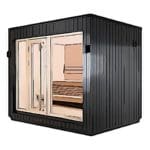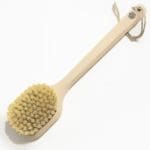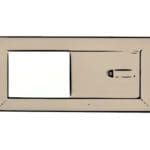Heating Water with a Wood Burning Sauna

A shower or cold plunge is an important part of a good sauna session for many. If warm water is your preference, there are some great ways to get “free” hot water from your wood-burning sauna stove.
Wood stove hot water tanks and heat exchangers can provide plenty of hot water for hot showers using heat already generated from wood stoves for the sauna session. They provide a more sustainable way to bathe and can provide an awesome indoor or outdoor shower experience year-round.
Depending on the storage insulation, this can provide hot water for many hours after using the wood stove.
Warm water can also prepare sauna whisks, often dipped in warm water before use.
Adding thermal mass of water to your sauna is an added benefit, which will likely improve the quality of your sauna-like adding more rocks would. Be aware however that adding a water tank to the side of your wood stove could slow down the time to heat the room.
Our Favorite Option: The Harvia Pro 20 LS
The Harvia Pro 20 LS brings a 30 liter fixed water tank to the side of a trusted Harvia Pro 20 wood burning stove. This is a beastly way to provide adequate hot water for some showers or whisks, and it a great source of thermal mass. See all available Harvia sauna heaters here.
Please note that the water in the tank shouldn’t freeze, which makes this difficult in some climates.
The Easy Way: Buy a Chimney Tank Attachment or Heat Exchanger
Our favorite option for getting hot water from your sauna heater is a HUUM Water exchanger, available as add-ons on the HUUM HIVE Heat and HUUM HIVE Wood sauna stoves. Reach out to see if these heat exchangers are compatible with your sauna heater.
The easiest and most fool-proof way to get hot water in your sauna is to purchase an attachment for your sauna heater simply.
Harvia has a hot water tank between the wood stove and the chimney. You can check the price and buy it here on Amazon.
It will work for any wood-burning stove and is a convenient way to have hot water in the sauna or fill a bucket for a cowboy shower.
If placed high enough, the water could be piped to a shower head for a proper shower.
Lamppa Kuuma wood-burning stoves offer a couple of different attachments including a simple holding tank that attaches to the side of the stove or a copper coil system that would connect to a separate holding tank.
The old Finns had it right again
Adding an off-grid showering experience to your sauna practice can be invigorating. Like the sauna itself, this is an old practice ripe for revival.
Before ‘fancy indoor plumbing,’ many old saunas had coils in the wood-burning stove that heat up a domestic water tank. This practice has fallen out of favor but done right it can be useful. Back in the day, these sauna hot water tanks were the only source of hot water at many homesteads. They were used to was clothes, bathe, and clean. There are countless stories of families in the 1930 and 40s (and earlier) who bathed this way, especially in Scandinavian countries, Canada, and northern United States.
If you’re living off the grid, or want to cut your reliance on energy companies, using your wood burning sauna for hot water can provide some modern comforts.
Water Tank Location
Like rocks, sauna stove water tanks can be placed in different locations in and around the wood stove and flue. They may surround the entire stove, be front-mounted, rear-mounted, or directly above the stove. The most important factor for water tank placement is whether you have an internal or external feed stove.
We recommend having a sauna tank on the opposite side of the stove opening. Heat will naturally move backwards toward the tank and you’re in business. One complaint with water tanks that contact the lower portions of the stove is that is not benefiting from the hotter sections of the stove and take longer to heat.
Regardless of placement, the best thermal transfer will be a physical weld between stove and tank.
Kuuma offers a water tank mounted on on the side of the sauna stove. Some DIY sauna enthusiasts have had luck using beer barrels on the side of their stoves. Of course, a well designed hot water system would allow
Running Water In Sauna
Bringing water buckets from the house or lake into the sauna is the tried and true method for meeting a typical saunas water requirements. Cold water can be stored in the changing room or outside, and hot water can be stored on the stove. Use a 3rd bucket to mix for desired temperature as the hot bucket gets too hot. By the end of the 3rd section, you’ll probably be using the cold bucket for bathing, as it will be refreshing.
But what if you want to step up your game? What’s the best way to get running water into a sauna for bathing, pouring on rocks, etc.?
If you have access to lake water, we recommend first pumping it to a storage container either underground or above the sauna.
Sauna Shower
The shower itself can be located inside the hot room, inside the dressing room, or outside the sauna – depending on preference. Mokkisuihku is one of many Finnish companies making showers that integrate with hot water sauna systems.
The hot water tank should always be in the hot room as close to the stove as possible, so consider that the further you have to run hot water from there, the more heat you will lose.
It’s often best to put a barrel shower outside the sauna.
Pros
- Supply of warm or hot water to use for dumping on rocks, which creates a better heat/steam/löyly
- Increases the thermal mass of the sauna which provides a more steady temperature in the sauna. This is the same reason for rocks around the stove, to capture and maintain heat (besides providing steam).
- With more thermal mass, your sauna experience will last longer, even after the stove stops producing heat
Cons
- It takes longer to heat up a sauna with more thermal mass.
- Can be dangerously hot, please don’t scald yourself.
- As water vaporizes and pushed through coils, every system has a unique sound. It can be a pro or a con, depending on the hot water system and if you find it relaxing or annoying. Finns even have folklore around these sounds, and has even been called ‘Finnish Rock Music’
Tips for Sauna Water Heating Tanks
- 10-25 gallons is a common tank size. We recommend 20-25 gallons for most saunas.
- Make sure to choose a water tank built out of a material that will not rust, we recommend stainless steel.
- You can fill your tank with lake or well water if you have it. Consider a solar pump/battery system if your sauna is already off the grid. Having a steady lake supply will come in handy if you use a lot of water for steam (you know who you are).
- Plan your drainage before installation. Make sure you have room to fit a large bucket under the tank, or attach a hose if there is a fitting. Just make sure you leave plenty of room for maintenance.
- Mind the frost. It’s best to never let your tank freeze, no matter how well the tank is built. The expansion from freezing will shorten the life of the tank and eventually cause leaking. If your outdoor sauna is used frequently enough, you may not have to drain it between sessions, especially if you have a well insulated sauna. If you are in this category, or you think you might ever forget FOLLOW THE NEXT TIP:
- Throw a small block of wood in your water tank, the ice will push the wood up instead of pushing against the sides of the tank.
- Many sauna hot water systems become pressurized and should have a pop off safety installed, usually at the top.
- Make sure any coils your using are pressure tested – they will encounter very high temperatures and homemade and DIY water heating methods have developed a reputation for scalding steam explosions.
- Find a way to safely test the temperature of your water to make sure it is safe to use. After about 1 hour of sauna the water will likely need to be mixed with cold water before use.
Price and Recommendations
Kuuma offers copper coils for $300 and a stainless steel sauna hot water tank for another $300. These are built specifically for their wood burning sauna stoves.
Nipps offers a wood stoved with attached tank that heats up very quickly and releases steam.
Tankless Water Heaters
If you have access to grid electricity, a tankless water heater might be a more elegant solution for sauna showers. These heat up quickly, and allow for quick shower before sauna round 1, where a wood heated water tank might still be cold.
Solar Hot Water
Heating your water with solar thermal energy is almost always an option. There are many good plans at BuilditSolar.com . Solar thermal required a large, heavily insulated water tank, the larger and better insulated it is, the more reliable it will be for hot water.


 Prebuilt
Prebuilt Sauna Brushes
Sauna Brushes Vents
Vents
1 thoughts on “Heating Water with a Wood Burning Sauna”
Comments are closed.